Media | Articles
Ranked: 5 Ways to Break a Stuck Fastener
Any car is an assembly of parts. Since bolted joints are both strong and easy to assemble, just about any service or maintenance on a car or truck requires you to remove some type of bolt. Anyone who has worked on a car for more than three minutes knows that even a larger project is not so bad if the hardware is not difficult to deal with. Those with many years of experience know how difficult corroded and stuck fasteners often give up, but convincing them to surrender requires force. How you generate that force is defined by the severity of the situation. Let’s look at the levels of bolt persuasion, from least to most aggressive, and some of the reasons why they fall in this order.
Level #5: Open-End Wrench
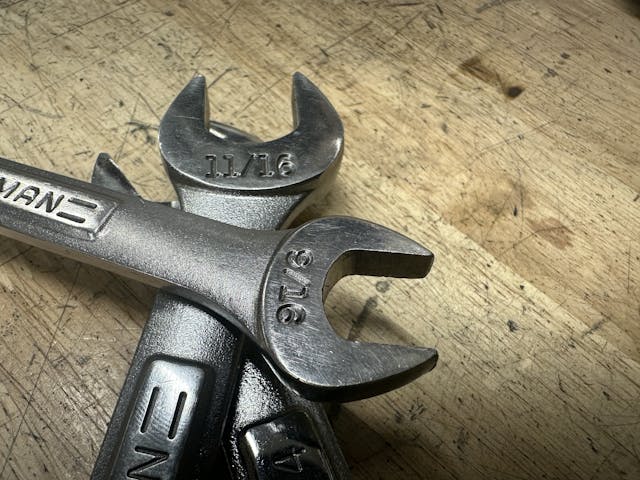
An open end wrench is nothing more than two parallel surfaces that meet two sides of a fastener. This often means only truly gripping near the corners due to tolerance in production of both the hardware and the tool. Sometimes, the fit is plenty tight and less than one foot of leverage is plenty. There is a reason wrenches are standard in every automotive toolkit since people started working on cars; wrenches pack light, are simple to produce, and are durable for many years if not abused. Sure, long-handle versions exist, but most of those are box-end, which means they are basically a worse version of a …
Level #4: Socket and Ratchet

The combination of a socket and a ratchet steps things up in a couple different ways: First, by providing additional contact points with the stuck fastener. Whether 12-point or 6-point, a socket provides more even contact with the fastener, and a ratchet allows us to shift the angle of the lever to maximize the force applied by our muscles. That handle can easily be exchanged for a …
Level #3: Longer Ratchet
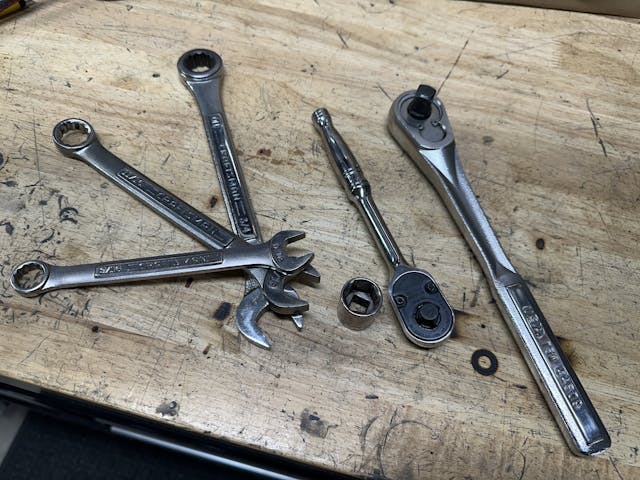
The socket is giving us good positive engagement on the hardware, so if it hasn’t moved yet, we must add force. Long-handle ratchets are handy, because it can be difficult to reposition a long wrench multiple times just to rotate a fastener one turn. Sadly, the most helpful part of a ratchet—the rotating head—is also the weak point, and if you treasure your tool you will likely grab one with a longer handle before adding a cheater bar or hitting the handle of your ratchet with a hammer. Sure, you can buy rebuild kits for some ratchets … or you could avoid stripping out the catch pawls inside the head in the first place.
Level #2: Impact Wrench
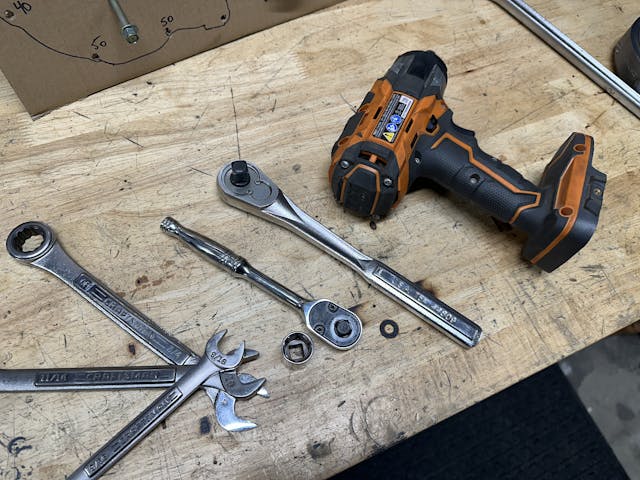

Leaning your weight on a long lever is one way to impart force. The other is to apply it suddenly with a spinning hammer. That is the basic function of an impact wrench, which generates high amounts of force in short bursts to help break loose the corrosion that forms inside threaded joints. Better yet, impact wrenches are powered by compressed air or by batteries, not by elbow grease, making them the hot ticket when dealing with stuck stuff. The only problem is that the torque capabilities of an impact wrench are limited by design, as the motor, hammer, and anvil can go get so large before the tool becomes unwieldy. You might have to switch back to brute force and grab the …
Marketplace
Buy and sell classics with confidence
Level #1: Breaker Bar
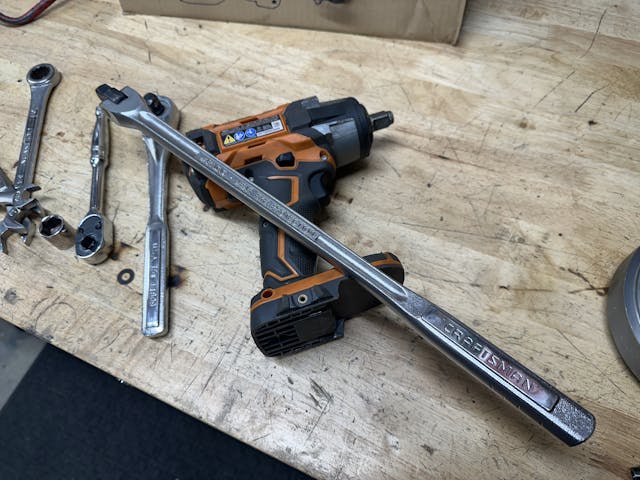
At the end of the day, physics always wins. While inconvenient compared to the luxury of an impact wrench, using a long bar to apply torque to a proper-fitting socket is by far the best way to put absurd amounts of torque onto a stuck fastener.
A long enough lever will snap the hardened head off every breaker bar you can find. And that is what you are often hoping for, at this point—the sweet release of tension by any means necessary. Just break already. The drill and tap set are already on the workbench.
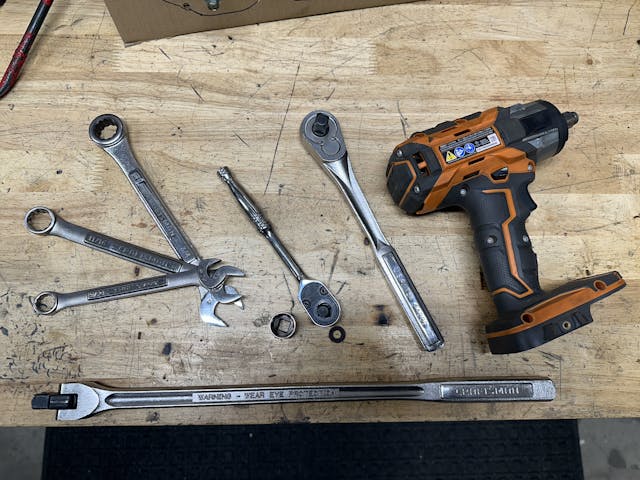
***
Check out the Hagerty Media homepage so you don’t miss a single story, or better yet, bookmark it. To get our best stories delivered right to your inbox, subscribe to our newsletters.
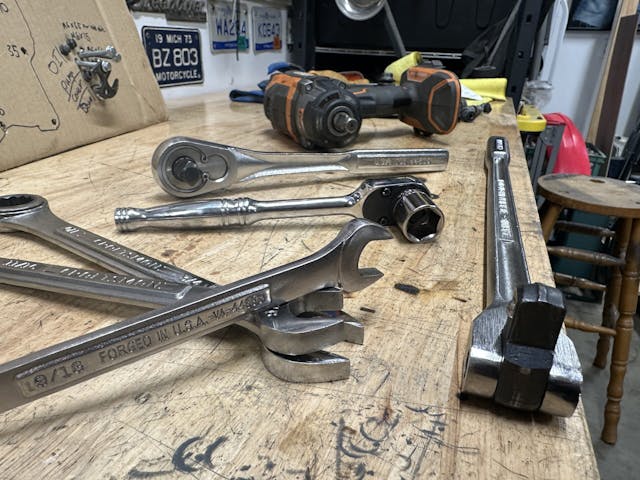


















I assume you are referring to breaking the bolt and not the breaker bar for the #1 tool. If you are snapping the head off the breaker bar, then it’s time for a torch.
That’s what I was thinking as well, especially considering the reference to the tap set already on the workbench. However, I have broken more than my share of breaker bars, usually the pin, but recently I twisted a half inch square drive into a twisted mess
No doubt about that, you can’t beat the torch.
Kevin says “… you can’t beat the torch”.
Kevin, wait until you try an induction tool; your life will never be the same 😉
I was using a torch (just simple MaPP gas) to help get the exhaust flange nuts off the (Inconel) studs on a BMW while the customer looked on. His face shone sheer fear and terror!
I bought one of Induction Innovations first tools about 15-yrs ago (honestly, it looks homemade, like a kid’s science project__their current line of tools is much nicer) and the first time another BMW owner saw me using it under his car to remove the exhaust flange nuts, the look of utter amazement on his face made me think I was The Coolest Guy in the Universe, LOL!
Another mechanic showed me this. . . . Use the torch, yes, but immediately after heating apply water from a squirt bottle to rapidly cool the offending component down. This works really good with frozen fittings on hydraulic brake lines.
I heat the area , then add a ice cube the head of the bolt or screw .
Amen….. the number 1 way….. a torch for sure. For brake lines, bolts, no matter what, on an old rusted bolt, torque will twist them of then you do have problem. As usual the author was WRONG!!!
Level # 0: Torch Set
Can’t be tight if it is a liquid!
We use that saying a lot in the steel mill lol
Question 1 is why is it tight? Is it just torqued tight? Sure, go for the big guns
Is it seized… time for a little more finesse.
If it is a seized bolt in a blind hole… you’re probably going to be in drill and tap mode before the day is out.
If threads are accessible, I use a caustic detergent, followed by heat, followed by ATF. The trick then is to apply force with a tight socket and well-squared ratchet… one with a long handle so you can apply steadily increasing force. If you take it right up to ‘I think it’s going to snap’, stop and repeat step 1. The trick is to avoid the tap if at all possible
Always go loosen, tighten, loosen, tighten, until it starts to turn.
If still no luck, lubrication, then heat, then impact gun.
Usually works for me
You left off the most basic of man’s tools. The BFH. Hitting a bolt or lug straight on can often break it free.
Also heating. Using a torch is a prime tool for breaking loose frozen bolts but the best today is induction tools that will heat bolts flameless.
Blaster Oil or other quality penetrant.
Have used propane, MAPP and oxy-acetylene but since being introduced to induction heating it is the go to solution for any situation where a 24” breaker bar fails. Added benefit as noted, no flame so risk of unintended consequences of burning some are virtually eliminated
I bought an Induction heater about a year ago. Don’t know how I ever lived without it. Best tool out there for this job.
Induction heaters are like magic; they can loosen a fastener in seconds that you might have fought with for hours. If space permits, dry ice can be used to shrink the parts and create slight clearance between them. One of my favorite oddball tools is an impact driver. Good especially for the big Phillips-head screws that mount door hinges. It provides an impact and torque at the same time, and doesn’t require air or electricity.
Good choice especially on screws!
Good induction heaters are under $ 300.00 and can be used over and over again. They are terrific in loosening stuck and rusted stuff. I believe they are easier to use work with than torches in a lot of situations.
Also hitting the bolt head or nut with a large hammer, (square in is key) will help to break loose corrosion bonds and allow fasteners to free up quickly.
Footnote to use of propane, MAPP and oxy-acetylene where a screw may be stuck, short of an induction tool, heat a spare screw driver point to as hot as you can handle and place on the offending screw head and allow for heat transfer. Plus use of penetrant, PB Blaster (“peanut butter blaster per our daughter), is wonderful! Works too for rare firearms with reluctant screws.
Have not heard the hot screwdriver tip previously. That’s an interesting thought. Thanks for sharing!
Unfortunately heating a screwdriver blade hot enough to transfer heat will usually spoil the hardening of the blade itself, so if you do this, do it with an expendable screwdriver.
And BTW, I actually snapped off the head of a Craftsman 1/2″ breaker bar,admittedly with a short cheater pipe attached. It was my late father-in-laws, and was pre-WWII. Took it in to Sears (this was a few years ago!) and they gave me a new one, no questions asked. Same with the more-than-a-few fine tooth 3/8″ Craftsman ratchet drivers that I applied just a little too much torque to…Sears stores had the rebuild kits in their tool department and they were fixed on the spot. Sigh…I miss Sears.
A good point about the hardness of the screwdriver. Another thought about that is that is heats (and therefore expands) the fastener, which should lock it even more solidly in its threads. I’ve always been taught to heat the surrounding material, not the fastener. Could be two roads to the same destination though. Will have to experiment some and see how this might help in the future.
Heat the fastener then quench – you need to break the bond of the rust crystals and expanding the fastener in the hole crushes the crystalline structure a quenching shrinks the fastener creating clearance
Great solution that I can attest to from personal experience, add some patience and it should win the battle!!👍
That took me back to a memory of my dad. He did the same thing. It was back in the ’70’s before he retired. Also snapped the end off of a Craftsman 1/2″ breaker bar. Took it into the local Sears store for replacement. Back then they would ask what year the tool was from. Dad thought for a moment and said-“well, that was from my first tool set-I was 16, so 1929.” The guy smiled and handed him a new one-a longer one than the one he had. I still have that bar.
I was working on a concrete form about 30 feet above the concrete floor and dropped my Craftsman ratchet handle. It basically exploded when it hit the ground. Sears replaced it.
I also miss the Sears craftsman generous warranty policy. However, I feel it was abused by way, too many people. I remember one time I was in the store to replace a broken half inch, swivel adapter and another customer at the counter, pointed out that next time, I should return the broken swivel pieces in two separate trips, because they will give you a whole replacement, even if you only bring half of it back. The man working on the counter said it’s true..
Or people that would deliberately break Craftsman tools they bought at garage sales just so they could get a new replacement.
Acetone and diesel 50/50 to penetrate. If that doesn’t work, HEAT.
I have used Acetone and ATF mixed 50/50 as an effective penetrant as well!
Acetone orMEK plus ATF works on many things.. you need to mix a fresh bash each time use it
Level -1 is an induction coil. The gas wrench is maybe handier but induction coil heats the fastener not the surrounding hole!!
My step-dad, a trucker honored by the ATHS ‘Long Haul’ Award (truckin’ since 1932) always said “If that doesn’t work, use a bigger hammer.” Of course, if something broke, you still got the blame! I think it was his philosophy of life… “Road-Ranger Wick” Humble
Remember work smarter not harder.
You’re all missing one thing: Kyle’s title says these are ways to BREAK a stuck fastener – nothing there about breaking it loose! 😂
That is why I say work smarter not harder.
Better to avoid the problem than create the problem.
Again, “snap the hardened head off every breaker bar” must be a typo, right?
Combo wrench, ratchet and breaker bar exert a torque and a side force on the fastener; they turn it and bend it. Impact and T-handle exert mostly torque and little side force. A longer handle on a wrench or breaker exerts more torque and less side force, so a longer handle is less likely to break a fastener. I learned this from a statics professor in engineering but it seemed counter-intuitive.
When I have to get the ‘big pipe’ out to break loose a particularly steady fastener, I steady the head of the breaker bar, wrench, etc on some sort of support that is in line with the bolt. This minimizes side loading
When removing axle nuts, I often use a jack stand to rest the socket or ratchet head on while turning. I recently got a 3/4 ratchet wrench. It is heavy.
Big Pipe also known as ‘The Cheater’.
Kyle another influencer thats never turn a wrench in anger in his life……..WHAT ABOUT THE BLUE SPANNER GENIUS!?
What about it? A torch doesn’t provide any torque to loosen a fastener. Does it give you a fighting chance while using the items on this list? Yes. Cannot argue that. But “the blue spanner” does not loosen hardware.
Fire wrench in these parts. Certainly part of the toolbelt… but it won’t get ’em off by itself… unless you are going to get surgical and slice the nut off of the bolt
Yeah! What Kyle said…
What’s with the anger and criticisms? ‘How to’ articles are written for people with varying levels of experience and are meant to elicit real-life comments with solutions that have worked, in this case, how to loosen stuck fasteners. Even if I find an article too basic for me, I’ll read the comments and usually learn a clever method to solve a problem or remind me of a long forgotten solution – such as Old Iron Guy’s reminder to use a candle on a heated bolt.
The Blue Wrench is guaranteed to break everything loose!
Five minutes spent reading this is five minutes of my life I will never get back…
Agreed. Not sure I understand the heading 5 ways to break a fastener…seems it should be 5 ways NOT to break a fastener….but I digress. Most people reading these tidbits already know what they can and can’t do…and it all depends on where the fastener in question is located. Near paint? – can’t use heat….etc.
I think the word loose is implied. Five ways to break a fastenner loose.
30 seconds reading this comment that I’ll never get back 🙂
Exhaust manifold bolts are my demise. Yes there’re hard, but rusted just the same. I Still have a Craftsman set I received for Christmas in 1969. It’s been added to in many ways, but not from abuse. Just needed accessories. Just curious, but won’t a heated screwdriver tip take the temper out and render it useless next time it’s used?
I wouldn’t ruin one of my good screwdrivers by heating the tip. David must be talking about small screws on firearms. Using the heat transfer method I think it would make more sense to grab an old bolt (or other metal item you don’t care about) with a pair of vice grips and heat the bolt red hot and then put it on the head of the screw.
You know what they say. Any Port in a storm 🙂 My point being ,If it gets the job done worry about the screwdriver later.
I just wasted 5 minutes and an additional 3 seconds after reading all that and your comment. Sorry I couldn’t resist, my humor isn’t for everyone 🤣
One other thing. The bolt you’re trying to loosen is rarely on it’s own. If the stuck one is part of an asembly, tighten all the other bolts as much as you can before using those methods. It can often make the difference. This works really well for a stuck wheel nut/ bolt.
I noticed that the tools in the picture say “Forged in the U.S.A.” They must be antiques.
Depends on your definition of antique. Those wrenches were part of a mechanics toolset that was given to me as a gift some time around 2006. Brand new from Sears. The breaker bar is aged a little more as I liberated that from my father’s toolbox when I left for college, but still hardly as vintage as some other tools I have added to my box since. All of these tools have spoiled me in terms of quality expectations though. They are better than their price tag 20 years ago makes you think.
That comment was meant to be a little “tongue in cheek”. It seems that practically all the tools for sale these days are “Made in China”. Your tools may not be antiques, but they are definitely from a different era.
I have a ¾” breaker bar. Used on audi v8 axle bolts with socket head female cap crews and maybe 450#ft (angle tighten). Breaking them loose required a four foot cheater pipe with wheels on the ground!! Some things can’t be heated, just big friendly torque!
That’s when Craftsman made great tools
Craftsman is a brand, not a manufacturer, and they were never “great.” If you want great tools, buy Snap-on.
Craftsman tools are still sold at Lowes home improvement stores. They still are stamped “forged in the U.S.A.”
The comments were better than the article. I was hoping for magic.
I’m a decent wrench, but no one has ever called me a magician and there are a lot of very experienced mechanics who read these pages. I always enjoy when they choose to share their experience and knowledge.
Kyle
I’m with you on that one. I am not a professional wrench but can think a few things through. Plus I have friends who may know a little more in case I get stuck (pun intended). I’ve found that stubborn, frozen nuts need a shot of Kroil and about an hour or so to penetrate. Longer is better but it is amazing how well that product will unfreeze frozen nuts from bolts. Heat has also worked for me on occasion such as a motorcycle fork rebuild that Kroil would not work. In case of a broken bolt head, I have emergency back up plan #2, an AST stud extractor kit (made in USA). In fact, I only buy made in USA tools but will also add German and British tools to my collection too. NO Chinese tools unless it something I need to bend or grind to suit the job and then toss away. That’s their only purpose.
The comment section is my favorite part; a large soldering gun is a good way to apply heat as well. The induction heaters are supposed to be good. I don’t have one. Don’t think I need one- I quit working on Rusty stuff a while ago.